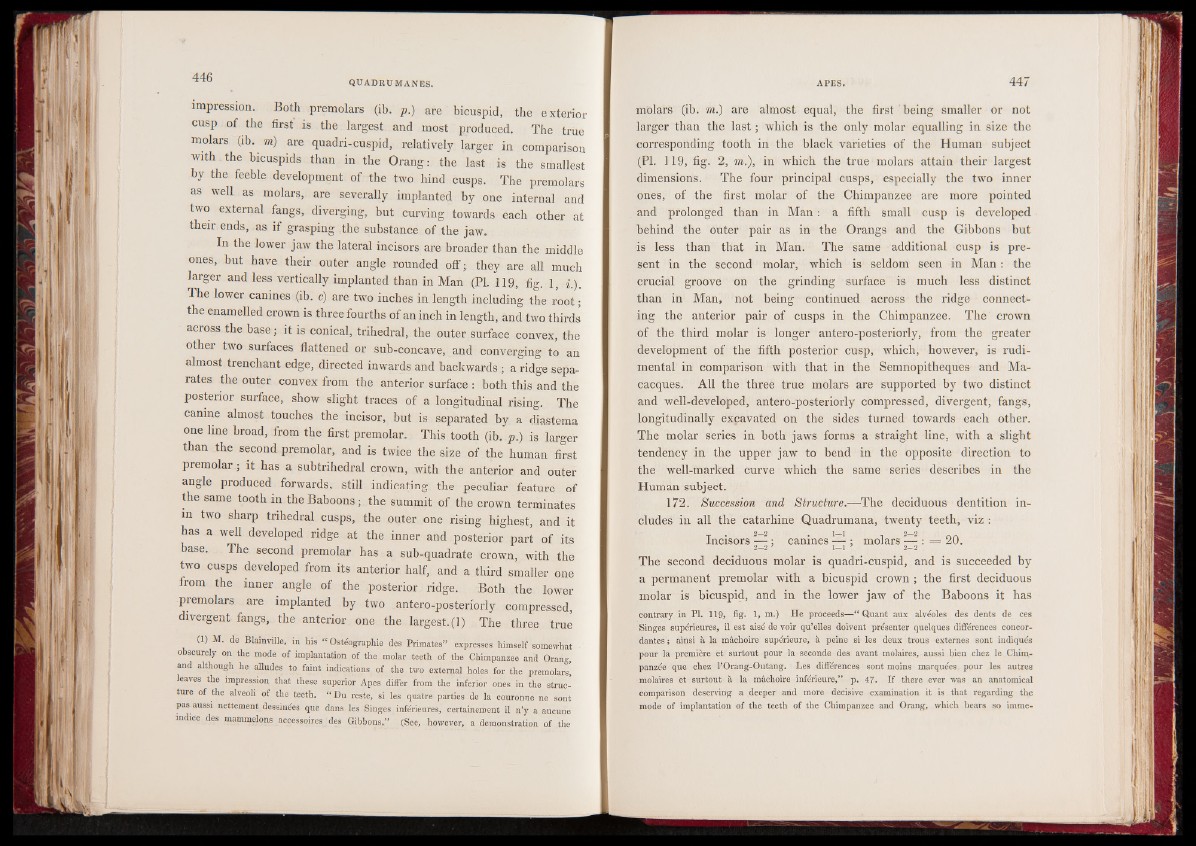
impression. Both premolars (ib. p.) are bicuspid, the exterior
cusp of the first is the largest and most produced. The true
molars (ib. m) are quadri-cuspid, relatively larger in comparison
with , the bicuspids than in the Orang: the last is the smallest
by the feeble development of the two hind cusps. The premolars
as well as molars, are severally implanted by one internal and
two external fangs, diverging, but curving towards each other at
their ends, as if grasping the substance of the jaw.
In the lower jaw the lateral incisors are broader than the middle
ones, but have their outer angle rounded off ; they are all much
larger and less vertically implanted than in Man (PI. 119, fig. 1 , i.).
The lower canines (ib. c) are two inches in length including the root •
the enamelled crown is three fourths of an inch in length, and two thirds
across the base ; it is conical, trihedral, the outer surface convex, the
other two surfaces flattened or sub-concave, and converging to an
almost trenchant edge, directed inwards and backwards ;; a ridge separates
the outer convex from the anterior surface : both this and the
posterior surface, show slight traces of a longitudinal rising. The
canine almost touches the incisor, but is separated by a diastema
one line broad, from the first premolar. This tooth (ib. p.) is larger
than the second premolar, and is twice the size of the human first
premolar ; it has a subtrihedral crown, with the anterior and outer
angle produced forwards, still indicating the peculiar feature of
the same tooth in the Baboons ; the summit of the crown terminates
in two sharp trihedral cusps, the outer one rising highest, and it
has a well developed ridge at the inner and posterior part of its
base. The second premolar has a sub-quadrate crown, with the
two cusps developed from its anterior half, and a third smaller one
from the inner angle of the posterior ridge. Both the lower
premolars are implanted by two antero-posteriorly compressed,
divergent fangs, the anterior one the largest. (1) The three true
(1) M. de BlainviUe, in his “ Ostéographie des Primates” expresses himself somewhat
obscurely on the mode of implantation of the molar teeth of the Chimpanzee and Orang,
and although he alludes to faint indications of the two external holes for the premolars*
leaves the impression that these superior Apes differ from the inferior ones in the structure
of the alveoli of the teeth. “ Du reste, si les quatre parties de la couronne ne sont
pas aussi nettement dessinées que dans les Singes inférieures, certainement il n’y a aucune
indice des mammelons accessoires des Gibbons.” (See, however, a demonstration of the
molars (ib. m.) are almost equal, the first being smaller or not
larger than the last ; which is the only molar equalling in size the
corresponding tooth in the black varieties of the Human subject
(PI. 119, fig. 2, m.), in which the true molars attain their largest
dimensions. The four principal cusps, especially the two inner
ones, of the first molar of the Chimpanzee are more pointed
and prolonged than in Man : a fifth small cusp is developed
behind the outer pair as in the Orangs and the Gibbons but
is less than that in Man. The same additional cusp is present
in the second molar, which is seldom seen in Man : the
crucial groove on the grinding surface is much less distinct
than in Man, not being continued across the ridge connecting
the anterior pair of cusps in the Chimpanzee. The crown
of the third molar is longer antero-posteriorly, from the greater
development of the fifth posterior cusp, which, however, is rudi-
mental in comparison with that in the Semnopitheques and Ma-
cacques. All the three true molars are supported by two distinct
and well-developed, antero-posteriorly compressed, divergent, fangs,
longitudinally expavated on the sides turned towards each other.
The molar series in both jaws forms a straight line, with a slight
tendency in the upper jaw to bend in the opposite direction to
the well-marked curve which the same series describes in the
Human subject.
172. Succession and Structure.—The deciduous dentition includes
in all the catarhine Quadrumana, twenty teeth, viz :
Incisors — ; canines — ; molars — : = 20.
The second deciduous molar is quadri-cuspid, and is succeeded by
a permanent premolar with a bicuspid crown ; the first deciduous
molar is bicuspid, and in the lower jaw of the Baboons it has
contrary in PI. 119, fig* 1» m.) He proceeds—“ Quant aux alveoles des dents de ces
Singes supérieures, il est aisé de voir qu’elles doivent présenter quelques différences concordantes
; ainsi à la mâchoire supérieure, à peine si les deux trous externes sont indiqués
pour la première et surtout pour la seconde des avant molaires, aussi bien chez le Chim-
panzée que chez l’Orang-Outang. Les différences sont moins marquées pour les autres
molaires et surtout à la mâchoire inférieure,” p. 47. If there ever was an anatomical
comparison deserving a deeper and more decisive examination it is that regarding the
mode of implantation of the teeth of the Chimpanzee and Orang, which bears so imme